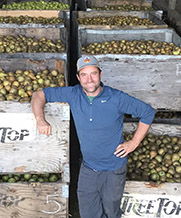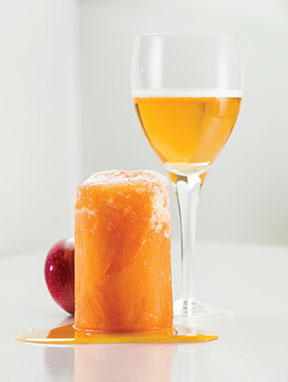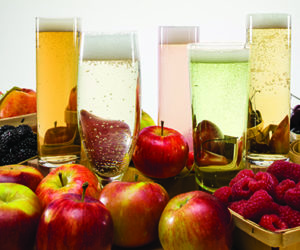
So-called “perry pears” that are extremely high in tannin and not fruit you would ever consider eating plain are what is often used to fermenter perry, though dessert pears work also, as one pro perrymaker explains.
Jeremy Hall and his wife, Erin Chaparro, founded Blossom Barn Cidery on his parents’ farm in southern Oregon’s Rogue Valley in 2018.
Our flagship perries that go into cans and kegs are primarily made with Rogue Valley-grown dessert Bosc and Comice pears. These are the pears that have dominated Oregon’s Rogue Valley pear industry going back to the 1880s and the locals love them. It’s the reason we decided to make perry instead of apple cider. These perries range from 100% culinary pears to 90% culinary pears co-fermented with fruit like cider apples, passion fruit, sour cherries, and strawberries. These are crowd-pleasing perries that generally appeal to people that are used to modern, semi-dry ciders.
Our perry pears from our young orchards are now producing enough pears that we have made small batches of perry that showcase the high-tannin and high-acid perry pears. We’ve been doing a co-fermented culinary/perry pear batch that is about 50-50. This perry has a much more tannic profile that we thought would appeal to the more traditional dry cider drinker. While this has been true, we have found that many novice cider drinkers like this perry too.
Dessert pears lend themselves to easy-drinking perries, with a creamy mouthfeel that work well with co-ferments with fruits with strong flavors, like sour cherries and passion fruit. These perries can be drunk after just a couple months of aging in a reductive environment. The perry pear-dominated perries we’ve made really showcase the depth and astringency of the perry pear and benefit from longer aging on fine lees with an occasional pump over to get some oxygen in the cider. This helps resolve all the short tannin into longer tannins that deliver a smooth yet complex perry.
We ferment all of our perries to dry, though we do backsweeten our seasonal perries with juice from local seasonal fruit like raspberries.
The juice undergoes treatment with pectinase to get the pectin out. We also add malic acid to our dessert fruit to get the pre-fermentation pH down to 3.8. After the acid and pecitinase treatments, we add 25 ppm SO2, mostly to control bacteria that convert the high citric acid content of the pears to acetic acid.
We use ES181 (a white wine yeast from EnartisFerm) to ferment perry. We have used DV10 also, but switched as we found the fermentation to be cleaner with no hydrogen sulfide (H2S) production with a longer, colder ferment. I would recommend a first timer use a commercial yeast — mostly to avoid H2S and volatile acidity (VA) that can dominate perry ferments. Or at least split the juice and use a commercial yeast on one and a wild ferment on the other.
If you have made hard apple cider but are new to perry, here are a few things to look out for:
1. Most pears benefit from cold storage to ripen. Even wild pears will ripen more consistently with a couple weeks or even a full month of cold storage. Juicing fully ripe fruit that hasn’t been cold stored can be like trying to get juice out of apple sauce. Pick the pears a little early, cold store them for at least a week, and pull them out for a day or two and then juice them.
2. Unless you’re going to keeve (a process of nutrient deprivation for a naturally sweet cider or perry), the high pectin content can create a lot of issues for fermentation, aging, and packaging. Treating the juice for pectin pre-fermentation is recommended. The citric acid content of pears is a big issue for VA, so controlling the populations of bacteria that cause VA is more important in perry than it is for apple-based cider or wine.
3. You can make a good perry out of any pears that are somewhat firm when ripe. Avoid varieties like Bartlett that are soft and creamy when ripe — they will be tough to juice.





